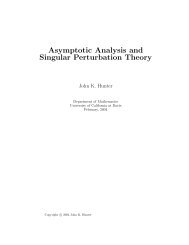Bounded Linear Operators on a Hilbert Space
Bounded Linear Operators on a Hilbert Space
Bounded Linear Operators on a Hilbert Space
Create successful ePaper yourself
Turn your PDF publications into a flip-book with our unique Google optimized e-Paper software.
206 <str<strong>on</strong>g>Bounded</str<strong>on</strong>g> <str<strong>on</strong>g>Linear</str<strong>on</strong>g> <str<strong>on</strong>g>Operators</str<strong>on</strong>g> <strong>on</strong> a <strong>Hilbert</strong> <strong>Space</strong><br />
theorem implies that {ϕn} is bounded. It follows that a weakly c<strong>on</strong>vergent sequence<br />
satisfies (a). Part (b) is trivial.<br />
C<strong>on</strong>versely, suppose that (xn) satisfies (a) and (b). If z ∈ H, then for any ɛ > 0<br />
there is a y ∈ D such that z − y < ɛ, and there is an N such that |〈xn − x, y〉| < ɛ<br />
for n ≥ N. Since xn ≤ M, it follows from the Cauchy-Schwarz inequality that<br />
for n ≥ N<br />
|〈xn − x, z〉| ≤ |〈xn − x, y〉| + |〈xn − x, z − y〉|<br />
≤ ɛ + xn − xz − y<br />
≤ (1 + M + x) ɛ.<br />
Thus, 〈xn − x, z〉 → 0 as n → ∞ for every z ∈ H, so xn ⇀ x. <br />
Example 8.41 Suppose that {eα}α∈I is an orth<strong>on</strong>ormal basis of a <strong>Hilbert</strong> space.<br />
Then a sequence (xn) c<strong>on</strong>verges weakly to x if and <strong>on</strong>ly if it is bounded and its<br />
coordinates c<strong>on</strong>verge, meaning that 〈xn, eα〉 → 〈x, eα〉 for each α ∈ I.<br />
The boundedness of the sequence is essential to ensure weak c<strong>on</strong>vergence, as the<br />
following example shows.<br />
Example 8.42 In Example 8.38, we saw that the bounded sequence (en) of standard<br />
basis elements in ℓ 2 (N) c<strong>on</strong>verges weakly to zero. The unbounded sequence<br />
(nen), where<br />
nen = (0, 0, . . . , 0, n, 0, . . .),<br />
does not c<strong>on</strong>verge weakly, however, even though the coordinate sequences with<br />
respect to the basis (en) c<strong>on</strong>verge to zero. For example,<br />
<br />
x = n −3/4 ∞<br />
n=1<br />
bel<strong>on</strong>gs to ℓ 2 (N), but 〈nen, x〉 = n 1/4 does not c<strong>on</strong>verge as n → ∞.<br />
The next example illustrates oscillati<strong>on</strong>, c<strong>on</strong>centrati<strong>on</strong>, and escape to infinity,<br />
which are typical ways that a weakly c<strong>on</strong>vergent sequence of functi<strong>on</strong>s fails to c<strong>on</strong>verge<br />
str<strong>on</strong>gly.<br />
Example 8.43 The sequence (sin nπx) c<strong>on</strong>verges weakly to zero in L 2 ([0, 1]) because<br />
1<br />
0<br />
f(x) sin nπx dx → 0 as n → ∞<br />
for all f ∈ L 2 ([0, 1]) (see Example 5.47). The sequence cannot c<strong>on</strong>verge str<strong>on</strong>gly to<br />
zero since sin nπx = 1/ √ 2 is bounded away from 0. In this case, the functi<strong>on</strong>s
















